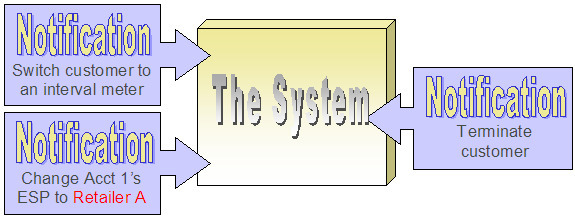The Big Picture of Notification Processing
We use the term "notification" to reference the electronic transactions that you exchange with third parties when:
- They need information about a customer.
- They need to change something about a customer.
For example, an electric service provider may send a notification to an electric distribution company when a customer elects to use them as their energy provider.
You may have to support a wide variety of notifications. For example:
- You may receive a notification that tells you to switch a customer's energy service provider to a different provider (if you are a distribution company).
- You may receive a notification that asks for the last 24 months of consumption history for a customer (if you maintain consumption).
- Etc.

When a notification is received, the system responds by creating a workflow process. The related workflow process contains workflow events and it is the events that actually do whatever needs to be done (e.g., change the customer's service provider, create field activities, stop service, etc.).
In addition to incoming notifications, the system creates outgoing notifications when:
- It needs to respond to an incoming notification. For example, if an incoming notification requests a customer's consumption history, the system must send the consumption history by creating an outgoing notification.
- It needs to apprise a third party that something has changed about the customer. For example, if a customer stops service, the system must tell the various service providers of such.
The topics in this section describe how notifications are interfaced into and out of the system.
